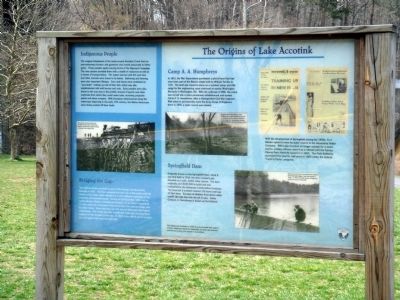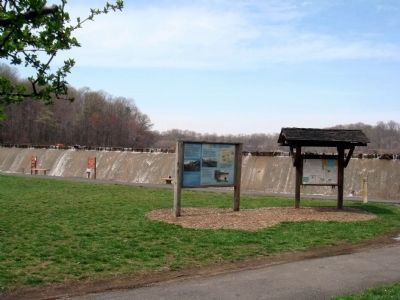Springfield in Fairfax County, Virginia — The American South (Mid-Atlantic)
The Origins of Lake Accotink
Indigenous People. The original inhabitants of the lands around Accotink Creek lived as semi-sedentary hunters and gatherers who moved seasonally to fallow game. These peoples spoke varying forms of the Algonquin language. The river system provided them with a wealth of resources as well as a means of transportation. The waters teemed with fish and deer and other animals were drawn to its banks. Gathering and farming were also important lifeways. Corn and beans were combined as “succotash” making up half their diet, which was also supplemented with wild berries and nuts. Early peoples were also drawn to the area due to the prolific amount of quartz and other materials from which they could make tools, including projectile points and stone scrapers. With European advancement along the waterways beginning in the early 17th century, the Native Americans were slowly pushed off their lands.
Bridging the Gap. The railroad trestle was built as part of the Orange and Alexandria Railroad in 1851. The line connected the port city of Alexandria with the interior of the state, which allowed for a more efficient exchange of raw materials and imported goods. During his 28 December 1862 raid on nearby Burke’s Station, Confederate General J.E.B. Stuart dispatched 12 men under the command of Fitz Lee to burn the railroad bridge over Accotink Creek. Stuart also tore up the rails and cut telegraph lines before withdrawing. The trestle was later rebuilt and continued carrying Union supplies for the duration of the war. In 1917 it was rebuilt out of wrought iron and again from concrete and steel.
Camp A. A. Humphreys. In 1912, the War Department purchased a plot of land that had once been part of the Belvoir estate built by William Fairfax in 1741. The land was meant to serve as a summer camp and rifle range for the engineering corps stationed at nearby Washington Barracks in Washington, DC. With the outbreak of WWI, the camp was turned into a more permanent establishment and named Camp A. A. Humphreys, after a distinguished Civil War engineer. With plans to permanently move the Army Corps of Engineers there in 1919, a water source was needed.
Springfield Dam. Originally known as the Springfield Dam, when it was first built in 1918, the dam created Lake Accotink as a safe, stable water source. The dam originally cost $100,000 to build and was contracted to the Amburson Construction Company. The reservois it created covered 110 acres and was 23 feet deep. Because of siltation from storm water runoff, the lake has now shrunk in size. Today Camp A. A. Humphreys is known as Fort Belvoir.
With the development of Springfield during the 1950s, Fort Belvoir opted
to move its water source to the Alexandria Water Company. With Lake Accotink no longer needed for a water source, military officers used it as a retreat until the Fairfax County Park Authority leased in in 1960. The part Authority purchased the land for half price in 1965 under the federal “Land to Parks” program.
This display was developed in 2003 by Lake Accotink Park staff to enhance awareness about the noteworthy role that Lake Accotink and the surrounding land played in local history.
Topics. This historical marker is listed in these topic lists: Man-Made Features • Military • Railroads & Streetcars • Waterways & Vessels. A significant historical date for this entry is December 28, 1862.
Location. Marker has been reported missing. It was located near 38° 47.586′ N, 77° 13.076′ W. Marker was in Springfield, Virginia, in Fairfax County. Marker was on Accotink Park Road east of Southern Drive, on the right when traveling west. From Backlick Road (County Route 617), take Highland Street west to Accotink Park Road on the right. Accotink Park Road jogs to the left (follow the signs to the park) while Southern Drive continues straight ahead. Marker is at the parking lot under the railroad bridge. Touch for map. Marker was in this post office area: Springfield VA 22151, United States of America. Touch for directions.
Other nearby markers. At least 8 other markers are within 3 miles of this location, measured as the crow flies. Connecting Communities and Parks (a few steps from this marker); Orange and Alexandria Railroad (within shouting distance of this marker); The Civilian Conservation Corps (approx. 0.4 miles away); a different marker also named Orange and Alexandria Railroad (approx. 0.7 miles away); Ravensworth (approx. 1.1 miles away); a different marker also named Ravensworth (approx. 1.2 miles away); Springfield Station (approx. 1.8 miles away); Keene’s Mill (approx. 2.1 miles away). Touch for a list and map of all markers in Springfield.
More about this marker. Marker has three photographs and a reproduction of two newspaper pages. The caption on the left-most photograph reads “The wooden railroad trestle over Accotink Creek made an attractive target to Confederate raiders seeking to disrupt Union supply lines.” Center photograph shows dam building in progress: “Accotink Creek provided an ideal location for a water source because of its relatively short distance upstream from Camp A. A. Humphreys situated between Route 1 and the Potomac River. The photograph on the lower right of the marker has this caption: “Because the first dam threatened the integrity of the railroad bridge, it was dismantled in 1922. In 1943, the Army Corp of Engineers rebuilt the dam for $19,000.” On the upper right a reproduction of the front and inside page of the January 11, 1946 issue Belvoir Castle newspaper has illustrated article on the dam and lake entitled “4,000,000 Gallon Thirst Keep Water Crew Busy.”
Also see . . . Historic Lake Accotink Park. This website includes a review of historical markers in the park, notes on other points of historical interest, and a catalog of artifacts housed in the park's visitors center. There are also links to additional information about the park and a gallery of images submitted by local citizens. (Submitted on June 8, 2018.)
Credits. This page was last revised on March 18, 2023. It was originally submitted on April 15, 2008, by J. J. Prats of Powell, Ohio. This page has been viewed 4,756 times since then and 65 times this year. Last updated on November 16, 2022, by Jeff Wilson of North Springfield, Virginia. Photos: 1, 2. submitted on April 15, 2008, by J. J. Prats of Powell, Ohio. • Bernard Fisher was the editor who published this page.

